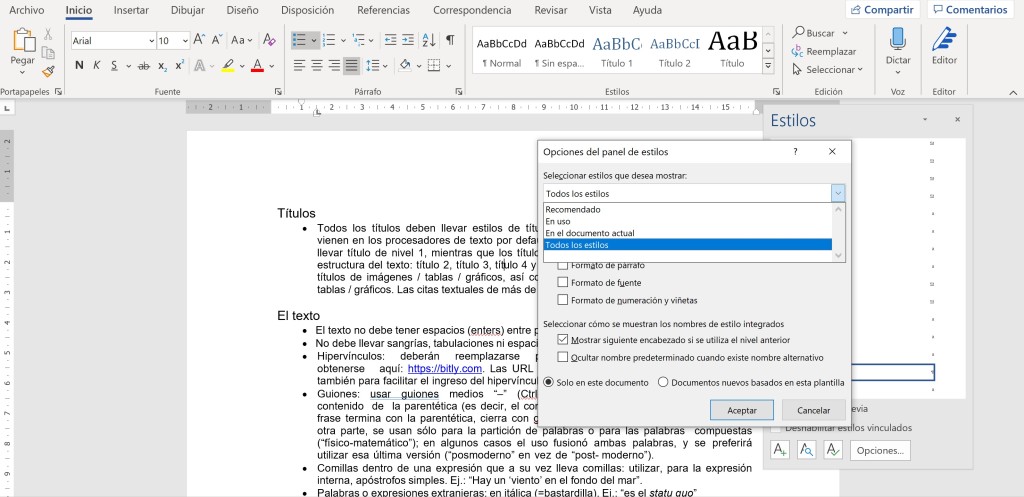Titles
- For both the book title and chapter titles, it is important to distinguish between the title and the subtitle. If the title field states: Kant’s Metaphysics: A Historical Approach, the title (Kant’s Metaphysics) should be separated from the subtitle (A Historical Approach).
- All headings should have heading styles applied using the default categories available in word processors. The chapter title should be the only one assigned a Level 1 heading, while internal headings should follow the structure of the text: Level 2 heading, Level 3 heading, Level 4 heading, and Level 5 heading. Level 6 heading should be applied to image/table/graphic titles, while Level 9 heading should be used for image/table/graphic captions. Direct quotations of more than 40 words should be formatted with Level 8 heading.
- If you do not see all the styles in Word, press Ctrl + Alt + Shift + S (Windows) or Command + Option + Shift + S (Mac). This will open the full styles pane. Then click “Options,” and under “Select styles to show,” choose “All styles.” Here is a screenshot in case you cannot find the option:
The Text
- Font type, size, and line spacing are not important.
- The text should not have extra spaces (enters) between paragraphs or between paragraphs and titles.
- Do not use indents, tabs, or spaces at the beginning of paragraphs.
- Use em dashes (—) for parenthetical phrases, without spaces around them. If the sentence ends with the parenthetical, it should close with an em dash followed by a period (—.). Use en dashes (–) for numerical ranges (e.g., 1980–1990) and compound adjectives like “pre–World War II architecture.”
- For nested quotations, use single quotation marks inside double quotation marks. Example: “There is a ‘wind’ at the bottom of the sea.”
- Foreign words or expressions should be italicized unless they are commonly used in English (e.g., café, déjà vu, kindergarten). Example: “it is the status quo.”
- For dialogues, use an em dash followed by a first-line indent, with no space before the character starts speaking. If the author includes annotations, they should be placed in a typical parenthesis using em dashes (except when they appear at the end of a sentence, in which case the closing dash is omitted).
- Use search/replace to ensure there are no unwanted double spaces, spaces before colons, spaces before commas, spaces before periods, etc.
- In American English, periods and commas always go inside the quotation marks (“This is correct.”).
- We recommend adding a Table of Contents at the beginning of the manuscript. Page numbers are not required as they will be adjusted in the final layout.
Direct Quotations
- Direct quotations within the text should be enclosed in quotation marks, and neither bold nor italics should be used to highlight them. Italics may be used to emphasize words or expressions within the direct quotation.
- For direct quotations exceeding 40 words, use a block quote format: indent the entire paragraph (without quotation marks) and maintain the same font size.
- Whenever a portion of a direct quotation is omitted, use three ellipsis points enclosed in brackets: […]. Similarly, any clarification not part of the original quote should be placed in brackets.
Bibliographic References
- We accept different citation styles (e.g., APA, MLA, Chicago), but consistency must be maintained throughout the text.
Capitalization Rules
Words That Should Be Capitalized:
- After a period or at the beginning of a document.
- After closing question or exclamation marks, as well as after ellipses when they function as a period.
- Proper names.
- Institutional nouns should be capitalized when they refer to a specific entity, as opposed to their general meaning. For example: Government/government, Church/church, State/state.
Words That Should Be in Lowercase:
- Political, military, academic, and religious titles should be in lowercase unless used directly before a name (e.g., President Lincoln, but the president said…).
How to Write Numbers in the Text
- Numbers referring to dates, ages, graphs, volumes, pages, units of measurement, and percentages should be written in Arabic numerals.
Notes
- Notes should be formatted as footnotes using the automatic function in the word processor (go to Insert, Footnote or References, Insert Footnote).
Legal Considerations for the Text
- Any inclusion of third-party texts (whether as a citation or paraphrase) must include the corresponding reference to the original source. Under copyright law, the permissible length for direct quotations depends on fair use (U.S.) or fair dealing (UK, Canada, Australia). Excessive quotation without proper attribution may constitute copyright infringement and result in legal consequences.
- Any critique directed at third parties (whether individuals or legal entities such as companies, associations, churches, foundations, etc.) must be substantiated with recognized sources (published authors, court rulings, news articles, etc.) or verifiable data. The publisher cannot publish critiques based on anonymous sources.
- The publisher will not accept any text containing defamatory, injurious, or offensive content against individuals or legal entities.
- The text must not contain any passages generated by automated tools.



